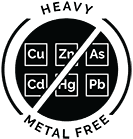From the early 20th century to today, iodine supplementation has played a significant role in addressing public health concerns worldwide, especially in preventing goiter and other iodine deficiency disorders.
Early Recognition of Iodine Deficiency
French chemist Bernard Courtois discovered iodine in 1811 during the production of saltpeter, an essential ingredient for gunpowder. He found that treating seaweed ash with sulfuric acid resulted in the release of a purple vapor, later identified as iodine.
It wasn’t until 1820, however, when a Swiss physician named Jean François Coindet, who had been treating goiters with seaweed (which was high in iodine), replaced seaweed with a tincture of iodine and found it to be effective as well. This was arguably the world’s first iodine supplement.
The Link to Goiter and Iodine Deficiency Disorders
By the late 19th and early 20th centuries, the scientific community had firmly established the connection between iodine deficiency and goiter. This led to concerted efforts to address this health concern, especially in regions known as “goiter belts,” where the soil lacked natural iodine. These areas included regions in the United States, Europe, and other parts of the world.
In the 1920s, the implementation of iodine supplementation started in earnest, primarily through the iodization of table salt. The United States became one of the first countries to introduce iodized salt to the general population in 1924, mainly to combat the endemic goiter in the Great Lakes, Appalachian, and Northwestern regions. The effectiveness of this public health measure was evident in subsequent reductions in goiter prevalence.
Wider Recognition and Global Efforts
Throughout the 20th century, the scope of iodine deficiency was recognized to extend far beyond goiter. It became known that iodine deficiency was the world’s leading cause of preventable intellectual disability in children. As a result, the World Health Organization (WHO) and the International Council for the Control of Iodine Deficiency Disorders (ICCIDD) spearheaded the call to ensure universal salt iodization to eliminate iodine deficiency disorders globally.
These initiatives led to significant global progress in the fight against iodine deficiency. By the early 21st century, many countries had adopted iodization programs, which substantially reduced iodine deficiency disorders.
Current Understanding and Ongoing Research
In recent years, the focus of research on iodine supplementation has expanded to include its potential benefits. Iodine’s role in maternal and neonatal health, its impact on cognitive development, the consequences of both deficiency and excess, and its interaction with other nutrients are all areas of active investigation.
Recent research has reinforced the importance of adequate iodine intake for pregnant women. However, it has also raised concerns about potential iodine deficiency in certain populations, such as vegans and those who avoid iodized salt due to dietary restrictions.
As we move forward, the rich history of iodine supplementation underscores its profound importance to public health and highlights the need for continued research and advocacy.
History of MAGNASCENT Iodine
In the year 2006, John Brookshire, an aerospace engineer passionate about holistic healing, began researching the exact formulation of nascent iodine from the 1930s. But unfortunately, the process used in the 1930s was lost when the discoverer of that version died without revealing the formulation.
With current technology and determination, Brookshire produced MAGNASCENT Iodine, a revolutionary nascent iodine with the first and only patent for consumable iodine. Its unique electromagnetic process breaks down the iodine molecule to produce magnetically charged and energized atoms of this essential element. While this mineral is in the nascent state, it comes in a unique form, which is consumable as a liquid supplement, to provide all the iodine health benefits that the body needs.
Other non-consumable forms of nascent iodine have very short lifespans and have limited uses.
Want to learn more about iodine supplementation?
Sign up for The Boost, a free e-newsletter by MAGNASCENT that gives you the boost you need to live your healthiest life. Get insights on the benefits of iodine, company news, and more.





